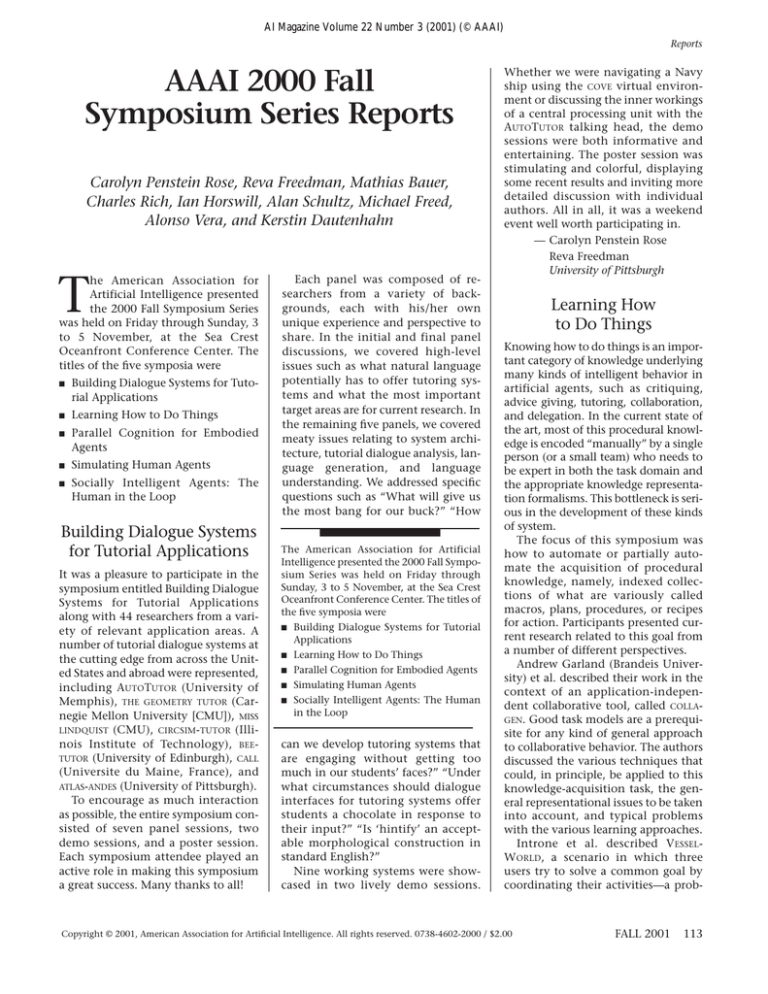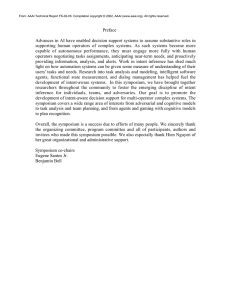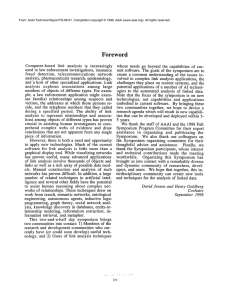
AI Magazine Volume 22 Number 3 (2001) (© AAAI)
Reports
AAAI 2000 Fall
Symposium Series Reports
Carolyn Penstein Rose, Reva Freedman, Mathias Bauer,
Charles Rich, Ian Horswill, Alan Schultz, Michael Freed,
Alonso Vera, and Kerstin Dautenhahn
T
he American Association for
Artificial Intelligence presented
the 2000 Fall Symposium Series
was held on Friday through Sunday, 3
to 5 November, at the Sea Crest
Oceanfront Conference Center. The
titles of the five symposia were
■
Building Dialogue Systems for Tutorial Applications
■
Learning How to Do Things
■
Parallel Cognition for Embodied
Agents
■
Simulating Human Agents
■
Socially Intelligent Agents: The
Human in the Loop
Building Dialogue Systems
for Tutorial Applications
It was a pleasure to participate in the
symposium entitled Building Dialogue
Systems for Tutorial Applications
along with 44 researchers from a variety of relevant application areas. A
number of tutorial dialogue systems at
the cutting edge from across the United States and abroad were represented,
including AUTOTUTOR (University of
Memphis), THE GEOMETRY TUTOR (Carnegie Mellon University [CMU]), MISS
LINDQUIST (CMU), CIRCSIM - TUTOR (Illinois Institute of Technology), BEETUTOR (University of Edinburgh), CALL
(Universite du Maine, France), and
ATLAS-ANDES (University of Pittsburgh).
To encourage as much interaction
as possible, the entire symposium consisted of seven panel sessions, two
demo sessions, and a poster session.
Each symposium attendee played an
active role in making this symposium
a great success. Many thanks to all!
Each panel was composed of researchers from a variety of backgrounds, each with his/her own
unique experience and perspective to
share. In the initial and final panel
discussions, we covered high-level
issues such as what natural language
potentially has to offer tutoring systems and what the most important
target areas are for current research. In
the remaining five panels, we covered
meaty issues relating to system architecture, tutorial dialogue analysis, language generation, and language
understanding. We addressed specific
questions such as “What will give us
the most bang for our buck?” “How
The American Association for Artificial
Intelligence presented the 2000 Fall Symposium Series was held on Friday through
Sunday, 3 to 5 November, at the Sea Crest
Oceanfront Conference Center. The titles of
the five symposia were
■ Building Dialogue Systems for Tutorial
Applications
■
Learning How to Do Things
■
Parallel Cognition for Embodied Agents
Simulating Human Agents
Socially Intelligent Agents: The Human
in the Loop
■
■
can we develop tutoring systems that
are engaging without getting too
much in our students’ faces?” “Under
what circumstances should dialogue
interfaces for tutoring systems offer
students a chocolate in response to
their input?” “Is ‘hintify’ an acceptable morphological construction in
standard English?”
Nine working systems were showcased in two lively demo sessions.
Whether we were navigating a Navy
ship using the COVE virtual environment or discussing the inner workings
of a central processing unit with the
AUTOTUTOR talking head, the demo
sessions were both informative and
entertaining. The poster session was
stimulating and colorful, displaying
some recent results and inviting more
detailed discussion with individual
authors. All in all, it was a weekend
event well worth participating in.
— Carolyn Penstein Rose
Reva Freedman
University of Pittsburgh
Learning How
to Do Things
Knowing how to do things is an important category of knowledge underlying
many kinds of intelligent behavior in
artificial agents, such as critiquing,
advice giving, tutoring, collaboration,
and delegation. In the current state of
the art, most of this procedural knowledge is encoded “manually” by a single
person (or a small team) who needs to
be expert in both the task domain and
the appropriate knowledge representation formalisms. This bottleneck is serious in the development of these kinds
of system.
The focus of this symposium was
how to automate or partially automate the acquisition of procedural
knowledge, namely, indexed collections of what are variously called
macros, plans, procedures, or recipes
for action. Participants presented current research related to this goal from
a number of different perspectives.
Andrew Garland (Brandeis University) et al. described their work in the
context of an application-independent collaborative tool, called COLLAGEN. Good task models are a prerequisite for any kind of general approach
to collaborative behavior. The authors
discussed the various techniques that
could, in principle, be applied to this
knowledge-acquisition task, the general representational issues to be taken
into account, and typical problems
with the various learning approaches.
Introne et al. described VESSELWORLD, a scenario in which three
users try to solve a common goal by
coordinating their activities—a prob-
Copyright © 2001, American Association for Artificial Intelligence. All rights reserved. 0738-4602-2000 / $2.00
FALL 2001
113
Reports
lem that is made more difficult by the
fact that each participant has only
limited perception capabilities. The
system’s task is to observe the users’
actions, identify segments that serve
one particular goal, and create a case
base for future use, thus enabling the
system to facilitate future coordinated
problem solving.
Soller et al. dealt with the problem
of supporting collaborative learning
among humans. Their main focus was
on training the system to recognize
(and support) effective collaboration
strategies using observed interactions
as input. First experiments provided
evidence that neural networks, or
HMMs, can serve the purpose of
acquiring the knowledge necessary to
support a human learning group.
Mathias Bauer (DFKI) et al. discussed the problem of how effective
communication can be achieved in
cases where the agent to be instructed
and its instructor share little knowledge. The application considered
involves information agents that are
to be programmed by demonstration
to identify and extract relevant information on their users’ behalf. A crucial
aspect of this work is the exact identification of the problem source, which
enables the system designer to
enhance the agent’s reasoning capabilities in a goal-directed way.
Another approach to programming
by demonstration was present by Lau
et al. The most important aspect of
their work is the use of a version-space
algebra to represent the various possible combinations of primitive actions.
The system learns repetitive sequences
of text-editing commands that can later be executed automatically when an
appropriate situation occurs.
Scholer et al. dealt with the problem
of acquiring the procedural knowledge
needed by an intelligent tutoring system. In a virtual reality environment,
the first acquisition step involves the
trainer demonstrating how to perform
certain tasks. Once the system has
learned a stable action sequence, it
starts experimenting on its own by
leaving out one step at a time and
checking the result of doing so in the
simulated environment. The representation is thus refined and abstracted
by identifying necessary precondi-
114
AI MAGAZINE
tions and removing unnecessary
actions.
Boylan et al. described a case-based
system designed to help users draft
effective business letters in English.
Their approach combined a constructivist, self-learning philosophy with
case-based reasoning technology.
Boicu et al. looked at the problem of
how a subject matter expert, who does
not have any knowledge engineering
experience, can effectively “teach” an
agent. The work used a civil engineering (for example, damaged bridge)
domain and was evaluated as part of
the Defense Advanced Research Projects Agency’s High-Performance
Knowledge Base Program.
The EXPECT Project, presented by Gil
et al., is a “classical,” broad knowledge-acquisition project aimed at facilitating the creation of knowledgebased systems in general. Procedural
knowledge is just one aspect of this
endeavor. EXPECT focuses on developing tools that enable the user to specify knowledge in English-like phrases,
that is, without having to learn a formal language, with the system automatically identifying gaps and inconsistencies in the knowledge.
Alissandrikis et al. discussed a biologically inspired approach to learning in
which agents try to acquire new skills
by imitating other agents. Interesting
effects can be observed especially in
cases where both agents have dissimilar
embodiments resulting in strongly
diverging basic action repertoires. In
these cases, the key factors affecting the
learning result are a metric that allows
the goodness of the imitated attempt to
be assessed and a subgoaling strategy
that allows the imitating agent to concentrate on the vital aspects of an
observed action sequence.
Finally, Marques and Pain examined
some of the philosophical and psychological underpinnings of the question
of what kinds of task model can be
learned.
The symposium was organized by
cochairs Mathias Bauer (DFKI) and
Charles Rich (MERL) and a committee
comprised of Andrew Garland (MERL),
Abigail Gertner (MITRE), Eric Horvitz
(Microsoft Research), Tessa Lau (University of Washington), Neal Lesh
(MERL), James Lester (North Carolina
State University), Henry Lieberman
(MIT Media Lab), Jeff Rickel (USC/ISI),
and Candace Sidner (MERL).
— Mathias Bauer
DFKI
— Charles Rich
Mitsubishi Electric Research
Laboratory
Parallel Cognition for
Embodied Agents
The AAAI Symposium on Parallel Cognition for Embodied Agents brought
together researchers from a broad
range of disciplines, ranging from
behavior-based robotics to knowledge
representation, to discuss the design of
distributed parallel reasoning and control systems. The group was modest in
size, allowing for in-depth presentations and discussions.
Much of the work presented
involved attempts to combine behavior-based systems with more traditional knowledge representation and planning techniques. Eyal Amire presented
work on reformulating the subsumption architecture in terms of first-order
logic theorem proving. Monica Nicolescu presented an architecture based
on abstract behaviors that can be
assembled dynamically into task-specific networks. Ian Horswill presented
a behavior-based architecture that
allows for explicit reasoning about the
states and capabilities of behaviors.
Other presenters described robots
that were patterned on existing biological systems. Metta, Panerai, and
Sandini presented work on a robot
that learns to orient a reaching behavior using techniques suggested by
human infant development. Brian
Scassellati presented a partial implementation of current theories of
shared social attention and theory of
mind. Alan Schultz presented work on
combining a reactive control system
with the ACT-R cognitive model.
The lively discussions allowed
authors to receive detailed feedback
with a range of viewpoints. A good
time was had by all.
— Ian Horswill
Northwestern University
— Alan Schultz
Naval Research Laboratory
Reports
Simulating Human Agents
Simulated human agents are a key
software component in many kinds of
application, including simulationbased training, interactive entertainment, and simulation-based tools for
analyzing human-machine system
designs. Creating sufficiently powerful
and realistic human agents presents
several challenges. To get the agent to
behave capably in dynamic, time-pressured, and otherwise demanding
application environments requires
adapting state-of-the-art AI techniques. Making the human model
accurate or believable requires identifying and incorporating relevant
human performance data. Finally,
reusable, well-documented software
architectures are needed to reduce the
time and expertise needed to construct new human-agent simulations.
The Symposium on Simulating
Human Agents gathered the top
researchers working in the area of Cognitive Modeling. SOAR, ACT-R, GOMS,
FORR , AMBR , OMAR , BRAHMS , and APEX
were among the modeling approaches
and architectures represented. Symposium attendees included researchers
from academia, industry, and government research-funding groups such as
ONR, NRL, AFRL, and ARI. Marvin
Minsky and Pat Hayes, the keynote
and plenary speakers respectively, contributed to the presentations and discussion sessions. The symposium was
designed to address practical questions
about the incorporation of existing AI
and human-performance modeling
technologies into applications such as
those listed previously. For example,
what AI technologies are most relevant for simulating human behavior?
What aspects of existing human-modeling architectures are most or least
helpful for building new applications?
Which aspects of human behavior are
most worth capturing in a human
modeling architecture, and which are
well enough understood scientifically
to be incorporated into general-purpose human-simulation tools? How
should one best go about filling in the
gaps where appropriate scientific findings do not yet exist?
These questions were motivated by
an initial belief that bringing together
researchers doing basic scientific mod-
eling with those doing or funding
applied modeling would begin a dialog leading to both better research
goals and more useful models. As it
turned out, most participants had
already determined that a closer coupling of applied and scientifically
motivated modeling was needed.
Many had begun bridging the gap in
their own research. Perhaps the most
significant consequence of the symposium was an increased awareness
among participants of a nascent community of like-minded researchers
with complementary methods.
The meeting achieved a broad critical evaluation of the state of the art in
cognitive modeling, including a characterization of what is right and what
is wrong with current modeling architectures and approaches. In particular,
the shortcomings of current approaches were seen to be that models behave
predictably (and are therefore, “gameable”), reactive planning is absent or
highly restricted, important performance modulators (for example,
stress, risk aversion, limited situation
awareness) are inadequately accounted for, models are not robust, and
models need to be far more adaptable.
The symposium also resulted in the
definition of achievable short- and
long-term goals, based on these concerns, required to take cognitive modeling efforts to the next level of performance. Critical domains, target
cognitive processes, and computational components were identified that
need to be explored to achieve these
goals. Given the broad representation
of cognitive modeling approaches
among the attendees, the symposium
achieved a remarkable degree of conceptual convergence on the current
concerns and goals in the area of simulating human agents.
— Michael Freed
NASA Ames Research Center
— Alonso Vera
University of Hong Kong
Socially Intelligent Agents:
The Human in the Loop
The Symposium “Socially Intelligent
Agents: The Human in the Loop” gave
an overview of the state of the art of
theory and applications in the active
and highly interdisciplinary area of
socially intelligent agents (SIA). Much
of this work is strongly inspired by
forms of natural social intelligence
characteristic of social animals, in particular, human beings (for example,
communicating verbally and nonverbally, expressing and recognizing emotions, reading another agent’s
“mind”). Different from meetings in
multigent systems (MAS) or distributed
AI (DAI), this symposium discussed the
design and evaluation of socially intelligent agents with the “human in the
loop,” that is, systems that can establish, maintain, and develop social relationships with human beings. Here,
the human can find himself/herself,
for example, in the role of user, observer, assistant, collaborator, competitor,
customer, patient, or friend of such
agents. The importance of such work is
demonstrated in application areas
such as electronic commerce; agents
for training, learning, and therapy
environments; agents for entertainment; and others. In all these application areas, the human user’s attitudes
toward the agent, in terms of believability, credibility, trust, and so on, are
important factors that determine the
acceptance and success of such a system and its utility in real-world applications. Therefore, an in-depth study is
required of theories and models originally developed in areas such as psychology, brain research, ethology, and
other fields not traditionally linked to
the domains of AI and software engineering. Also, human-agent interactions need to be studied and evaluated
carefully: Making agents “just like we
are” is not necessarily desirable and/or
feasible in particular application domains; compare discussions on autonomy versus control in humanmachine interface design.
Environments and devices that
interface humans (preferably nonintrusively) with agents and computers
was another main theme of the symposium. It was generally felt that the
more information an agent can acquire about intentions, emotions,
beliefs, and other internal and mental
states of a human, the better the agent
can adapt to the human and predict
his/her behavior and, possibly, changing attitudes. This is particularly rele-
FALL 20001
115
Reports
Diagrammatic Reasoning
Cognitive & Computational Perspectives
Edited by Janice Glasgow, N. Hari Narayanan, & B. Chandrasekaran
“Understanding diagrammatic thinking will be of special importance to those who design human-computer
interfaces, where the diagrams presented on computer screens must find their way to the Mind’s Eye.… In a society that is preoccupied with ‘Information Superhighways,’ a deep understanding of diagrammatic reasoning will
be essential to keep the traffic moving.” – Herbert Simon
800 pp, index. ISBN 0-262-57112-9, softcover
Published by The AAAI Press / The MIT Press
To order call toll free: (800) 356-0343 or (617) 625-8569 or fax (617) 258-6779. MasterCard and VISA accepted.
vant in scenarios where agents are
supposed to have “long-term” relationships with human beings and
requires adaptation and learning abilities for agents, that is, being able to
individually identify the human, as
well as learning and acting on interaction histories with humans.
Particular research challenges presented at the symposium were projects
that study heterogeneous agent societies, that is, how communities of
agents (hardware or software) can be
integrated and perform useful tasks in
human societies. In other projects, the
application area itself poses a particular challenge, for example, agent systems that are used in social problem
solving for adults or therapy for children with autism. In these application
116
AI MAGAZINE
areas, it is not only desirable but an
explicit goal that the agents be “persuasive,” that is, change behavior and
attitudes of the humans interacting
with them, and therefore requires
careful consideration of ethical issues.
Presentations, working groups, and
general discussions at the symposium
demonstrated (1) significant advancements in the field, compared to the
1997 AAAI Fall Symposium “Socially
Intelligent Agents”; (2) the importance of interdisciplinary work that
could advance the development of a
“theory of social minds,” both natural
and artificial; and (3) the identification of particular research challenges
(for example, unconstrained scenarios, heterogeneous scenarios) and
challenge scenarios that can help to
further develop the field and systematically explore design spaces and spaces
derived from application areas with
particular requirements. Future developments in social, emotional, and narrative intelligence research might lead
to “truly” socially intelligent agents,
for example, agents that have “natural” (nontrivial) conversations with
us, can recognize people as individuals
and “mental agents” with distinct
emotions and personality, and ultimately be agents that truly “care about
us.” For more information on the symposium and the field of SIA, see homepages.feis.herts.ac.uk/~comqkd/aaaisocial.html.
— Kerstin Dautenhahn
University of Hertfordshire




